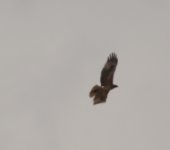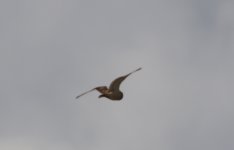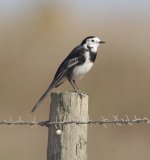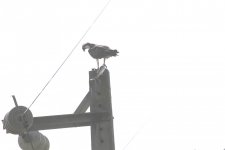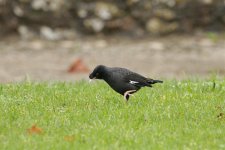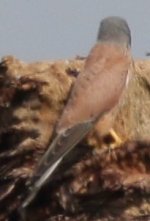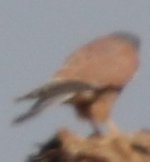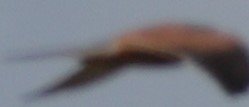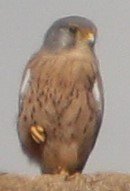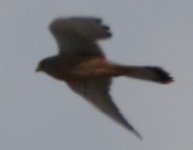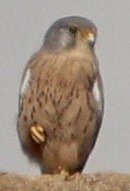rosbifs
PutAin STOP

All the birds today were seen on the Tagus area - Vila Franca
Interesting comments. In normal circumstances I don't always stop to look at Kestrels but at this time of year they might be Merlin or indeed Lesser - a Lesser has been hanging around the Algarve (interestingly I have just looked at the photos on ebird and its vey dark). In this case I was drawn to the two birds. They were both rufous and dark looking and through bins saw the female first. However, then the male and shit ALL blue head no moustache its a Lesser!
I grabbed the camera and they flew. Heres the caveats I was initially looking through the corner of the windscreen and against the light.
I took some snaps thinking I had enough to demonstrate lesser. I wasn't far from the visitor centre 'EVOA' so I went with what I had. None of the 'wardens' were there but I showed the pictures to the girl in the cafe. I also thought that I wouldn't have been the only person to see the birds. There is a radar project going on around the corner so I had a chat with them. Only then did the guy say are you sure of the id which I was at the time. I showed the pictures and thought hmmm do I actually have enough detail in the photo - so I went back.
A male Kes was on top of the post but at the same time a Short Eared Owl in flight and behind a Bonellis Eagle (both more interesting to me). Because of the rufous tones I had assumed it was the same bird. What are the odds of two males from different species showing this colouring on the same post 1 hour apart? All other Kestrels I had seen today were Common and not rufous...
I'm on limited optics - 50mm Nikon scope - but I tried to get some snaps as the bird flew...
Only back at base did I notice that the photos from the second visit, bird in post three, had a hint of the moustache - the blue looks a shade lighter or is that wishful thinking. Hence the have I been duped title. The bird I saw through the windscreen (subject to caveats above) didn't or at least I thought not.
I will have a bash at doing something more with the photos in the morning. I maybe have got lazy with my camera and the expert help I get on here but if the guy hadn't put a hint of doubt that my original photos weren't good enough I wouldn't have gone back!
Interesting comments. In normal circumstances I don't always stop to look at Kestrels but at this time of year they might be Merlin or indeed Lesser - a Lesser has been hanging around the Algarve (interestingly I have just looked at the photos on ebird and its vey dark). In this case I was drawn to the two birds. They were both rufous and dark looking and through bins saw the female first. However, then the male and shit ALL blue head no moustache its a Lesser!
I grabbed the camera and they flew. Heres the caveats I was initially looking through the corner of the windscreen and against the light.
I took some snaps thinking I had enough to demonstrate lesser. I wasn't far from the visitor centre 'EVOA' so I went with what I had. None of the 'wardens' were there but I showed the pictures to the girl in the cafe. I also thought that I wouldn't have been the only person to see the birds. There is a radar project going on around the corner so I had a chat with them. Only then did the guy say are you sure of the id which I was at the time. I showed the pictures and thought hmmm do I actually have enough detail in the photo - so I went back.
A male Kes was on top of the post but at the same time a Short Eared Owl in flight and behind a Bonellis Eagle (both more interesting to me). Because of the rufous tones I had assumed it was the same bird. What are the odds of two males from different species showing this colouring on the same post 1 hour apart? All other Kestrels I had seen today were Common and not rufous...
I'm on limited optics - 50mm Nikon scope - but I tried to get some snaps as the bird flew...
Only back at base did I notice that the photos from the second visit, bird in post three, had a hint of the moustache - the blue looks a shade lighter or is that wishful thinking. Hence the have I been duped title. The bird I saw through the windscreen (subject to caveats above) didn't or at least I thought not.
I will have a bash at doing something more with the photos in the morning. I maybe have got lazy with my camera and the expert help I get on here but if the guy hadn't put a hint of doubt that my original photos weren't good enough I wouldn't have gone back!
Last edited:




